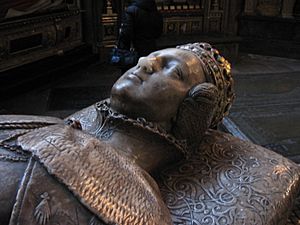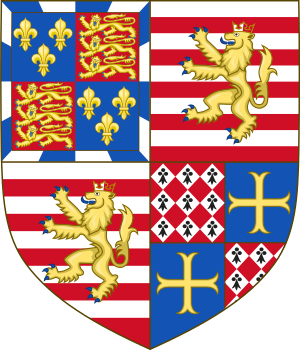Frances Grey, Duchess of Suffolk facts for kids
Quick facts for kids Frances Grey |
|
|---|---|
| Duchess of Suffolk | |
 |
|
| Effigy at Westminster Abbey | |
| Spouse(s) | |
| Issue | |
| Jane, Lady Guildford Dudley Katherine Seymour, Countess of Hertford Lady Mary Keyes Elizabeth Stokes |
|
| Noble family | Brandon |
| Father | Charles Brandon, 1st Duke of Suffolk |
| Mother | Mary Tudor, Queen of France |
| Born | 16 July 1517 Hatfield, Hertfordshire, Kingdom of England |
| Died | 20 November 1559 (aged 42) London, Kingdom of England |
| Burial | 5 December 1559 Westminster Abbey |
Frances Grey, Duchess of Suffolk, was an important English noblewoman. She was born Lady Frances Brandon on July 16, 1517, and passed away on November 20, 1559. Her mother was Princess Mary, who was King Henry VIII's younger sister. Her father was Charles Brandon, 1st Duke of Suffolk. Frances was also the mother of Lady Jane Grey, who was Queen of England for nine days in 1553. She also had two other daughters, Lady Katherine Grey and Lady Mary Grey.
Contents
Early Life and First Marriage
Frances Brandon was born in Hatfield, Hertfordshire. She spent her early years with her mother. Her parents' marriage was confirmed by the Pope in 1528. This made sure Frances was officially recognized as their daughter. Frances was close to her aunt, Catherine of Aragon, who was King Henry VIII's first wife. She was also a good friend of her cousin, the future Queen Mary I.
In 1533, Frances married Henry Grey, Marquess of Dorset. Their wedding took place at Suffolk Place in Southwark.
Frances had five children. Her first two, a son and a daughter, died when they were very young. Her three daughters who survived were:
- Lady Jane Grey (born around 1537 – died 1554) – She married Lord Guildford Dudley.
- Lady Katherine Grey (born 1540 – died 1568) – She married Henry Herbert and later Edward Seymour, 1st Earl of Hertford.
- Lady Mary Grey (born around 1545 – died 1578) – She married Thomas Keyes.
Frances was known as a strong and active woman. Her home, Bradgate Park, was a beautiful Tudor-style palace. After her two brothers died, her husband became the Duke of Suffolk. Frances made sure her daughters received a good education. Around 1541, Bishop John Aylmer became a tutor for her daughter, Lady Jane Grey, teaching her Greek.
Life at Court
As King Henry VIII's niece, Frances often visited the royal court. Her friendship with Catherine Parr, Henry VIII's last wife, helped her daughter Jane get a place in the queen's household. There, Jane met Henry VIII's son, Edward, who would later become king. When Henry VIII died in 1547, Edward VI became king. Jane continued to be part of the young king's close circle.
King Henry VIII's will had removed Frances and her sister Eleanor from the line of succession. However, their daughters were still included after Edward's half-sisters, Mary and Elizabeth. It is not fully clear why these changes were made.
Catherine Parr later married Thomas Seymour, 1st Baron Seymour of Sudeley. Lady Jane moved with them. Frances and her husband, along with other nobles, saw Jane as a possible wife for the young King Edward.
Catherine Parr died in 1548, and Jane returned to her mother's care. Thomas Seymour tried to get Jane back into his household. He still hoped to arrange a marriage between Jane and King Edward VI. However, the king began to distrust Seymour. Seymour was later found guilty of treason and executed in 1549. Frances and her husband convinced the Privy Council that they were not involved in Seymour's plans. Jane was sent home again. The Duke and Duchess gave up on marrying Jane to the king, as he was often ill.
In May 1553, Frances's daughter Jane married Guildford Dudley. He was the son of John Dudley, 1st Duke of Northumberland, who was a powerful figure during King Edward VI's reign. Her daughter Katherine married Henry Herbert. These marriages were seen as typical alliances between noble families at the time.
Some stories from the 1700s claimed that Frances treated her daughter Jane very harshly. However, there is no strong historical proof for this. Lord Guildford was not the most important match for Jane, given her royal background. Some historians believe the marriage was arranged by others, and the Suffolks did not favor it much at first. One historical account says Jane was "compelled to submit by the insistence of her mother and the threats of her father."
By June 1553, King Edward VI was very sick. His half-sister Mary was Catholic, and Edward feared she would reverse the English Reformation. Edward wrote a plan for the succession, called the Devise for the Succession. This plan skipped over his half-sisters and named his cousin Jane Grey as his heir. It also skipped over Frances, possibly because she was older and unlikely to have a son. Dudley supported this plan.
Frances and her husband were surprised at first. But after meeting with the king, Frances gave up her own claim to the throne in favor of Jane. She approved the plan for Jane to become queen.

Queen's Mother
King Edward VI died on July 6, 1553. Lady Jane was declared queen on July 10. Frances joined her daughter for the announcement and stayed with her in the Tower of London. Frances helped calm Jane down, convincing her that she was the rightful queen. However, their success was short-lived. Jane was removed from the throne on July 19, 1553, and Mary I became queen.
Frances's husband, the Duke of Suffolk, was arrested. But Frances quickly rode to Queen Mary in the middle of the night to ask for her family's freedom. She managed to meet the queen and secured a pardon for her husband. Frances blamed Northumberland for everything. She even suggested that Northumberland had tried to harm her family. Because of this, Queen Mary pardoned the Duke of Suffolk. Mary also planned to pardon Jane after her own coronation.
However, Wyatt the Younger started a rebellion against Mary in January 1554. The Duke of Suffolk joined this rebellion. He was captured, and the rebellion failed by February. Jane was now seen as too dangerous for Mary. Jane and her husband were executed on February 12, 1554. Jane's father was found guilty of treason and executed eleven days later. With two young daughters and her husband gone, Frances faced ruin. She had no property of her own. All her husband's belongings would go to the Crown. She pleaded with the queen for mercy. This meant she and her daughters had a chance to get some of their property back later.
Second Marriage and Death
Frances lived in difficult conditions during Queen Mary I's reign. Mary kept Frances close, showing her favor but also watching her closely. In 1555, Frances married her Master of the Horse, Adrian Stokes. This was a safe marriage for her. Any children they had would not be seen as a threat to the throne. Her childhood friend, Katherine Willoughby, had also married a gentleman, so Frances was following a familiar path.
Frances and Adrian Stokes had three children:
- Elizabeth Stokes (born and died November 20, 1554), stillborn.
- Elizabeth Stokes (born July 16, 1555 – died February 7, 1556?), may have died as a baby.
- A son (born and died December, 1556), stillborn.
Frances Grey, Duchess of Suffolk, died on November 20, 1559. Queen Elizabeth I paid for her burial at Westminster Abbey. Her daughter Katherine was the main mourner. Four years after Frances died, her husband placed a statue of her on her grave, which is still there today. The words on her grave, in Latin, mean:
-
- Nor grace, nor splendor, nor a royal name,
- Nor widespread fame can aught avail;
- All, all have vanished here.
- True worth alone Survives the funeral pyre and silent tomb
Reputation
Some people have thought that Frances and Henry Grey treated their daughter Jane badly. However, the writer Roger Ascham wrote about Jane years after meeting her. His writings might have been influenced by later events. A letter he wrote to Jane just a few months after his visit spoke highly of her parents. It praised Jane's good qualities and her parents' virtues. Another family friend, James Haddon, said that Jane was very close to her mother Frances.
Jane was fourteen years old and very smart. In Tudor times, obedience was highly valued. Jane was spirited, but even her beloved teacher agreed that it was sometimes necessary to "provide bridles for restive horses."
The claims of Frances mistreating her daughter and her role in trying to make Jane queen are still debated by historians. When Jane was with her husband, she heard that King Edward VI was changing his will to name her as his heir. Jane was surprised and wanted to visit her mother, but her mother-in-law refused. Jane then secretly went home. Frances was accused of forcing Jane to marry Guildford Dudley.
However, if Frances truly opposed the marriage from the start, Jane running to her makes sense. When her brother-in-law's children, Thomas, Margaret, and Francis Willoughby, became orphans, the Greys took care of them. Frances had already lost her eldest daughter, her husband, and much of her land. Still, she took care of Francis and Margaret Willoughby again. She arranged for the boy to go to school and took the girl to court with her and her surviving daughters.
Dramatic Representation
Frances, Duchess of Suffolk, has been shown in films and TV shows. Sara Kestelman played her in the 1986 film Lady Jane. Julia James played her in a 1956 episode of the BBC's Sunday Night Theatre.
See also
 In Spanish: Frances Brandon para niños
In Spanish: Frances Brandon para niños

